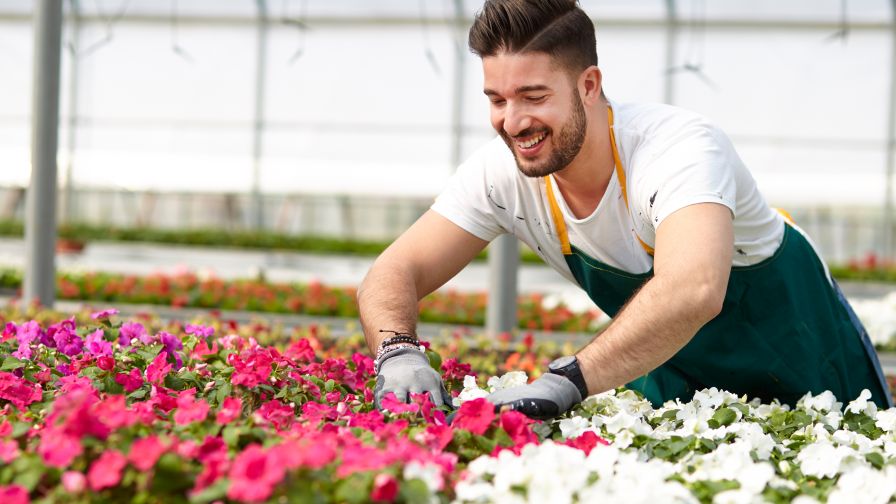Strain Selection Helping Cannabis Growers Differentiate From the Crowd

Growing cannabis is more of an art than a science, says Graham Farrar of Glass House Farms. Because of this, consistent quality is critical.
Photo by Paul Wellman
Cannabis growers face a unique challenge in picking the correct strains for growing style and end-product formulation, as well as perhaps the most important facet: consumer preference.
“Seasons matter; strains matter,” says Graham Farrar, President of Glass House Farms. “The right strain for the right season is important. And then there are three broader categories, indica, sativa, and hybrid, that come into play. And CBD and terpene production are two other interesting things you’ve got to think about as well.”
Farrar and his team at Glass House produce flowers across three separate greenhouse sites that encompass 500,000 square feet in and around the group’s home base of Santa Barbara, CA, a region that can legitimately lay claim as one of the most cutthroat retail cannabis markets.
That makes Farrar’s work as a sort of cannabis strain sommelier for the operation all the more important. The group has cultivated a solid reputation among consumers for its legacy O.G. (Ocean Grown) and Silver Haze strains. But in this game, you’re continuously evaluated by consumers based on the quality of your last crop.
“I’ve seen a number out there that there’s 4,000 strains (of cannabis) available to growers, but really who knows if that number is more like 3,200 strains and 800 of them have the wrong name on them,” Farrar says. “I’d say that growing cannabis is a lot more like making wine than it is like growing tomatoes. It’s more art than science.”
One tip Farrar has for newer growers is to make sure you have the destination of the plant in mind when curating strains. Growing style (greenhouse vs. fully controlled indoor vs. field) is important as well, but not so much as where the plants will end up.
“Are you growing for extraction? Or are you growing for flower? There is no strain that I can’t grow in the greenhouse,” he says. “So, from that point of view, you’re not going to end up picking a strain that can’t grow in a greenhouse.
“The curing, the drying, the trimming, it all has an influence on your final product,” Farrar adds. “And you can create strains for the canna-curious consumer or create strains they know about and seek out.”
Which is exactly what has put Glass House Farms, the largest greenhouse producer of cannabis in the Golden State, on the map.
Cultivating a Cannabis Brand
One of the hottest trends in cannabis is partnering with well-known and canna-conscious celebrities to serve as the face of a cannabis brand.
Former world heavyweight champ Mike Tyson has his popular Tyson’s Ranch brand in California and Nevada, and, of course, founding-fathers-of-all-things-cannabis Willie Nelson and Snoop Dogg have their respective plays in that regard, as well. That’s not too mention rapper Berner, who’s Cookies branded strains have been valued at the $80 million-plus mark of late.
For their part, when Farrar and the team at Glass House were approached to develop and cultivate a brand of dispensary products for teen starlet Bella Thorne, the group knew right away it had something unique and different from your typical cannabis celebrity branding campaign.
It was a chance to introduce the world of cannabis to an entire new audience.
“I think Bella was really interesting, because she really appeals and speaks to a demographic that the cannabis industry I’d argue has largely ignored, and that’s young women,” Farrar explains. “Cannabis is calorie free, hangover free, it’s relaxing and it’s great for things like yoga and hiking, kind of all of this stuff that you’d probably attribute as interesting for a 22-year-old young woman.”
Thorne’s Forbidden Flowers brand of retail cannabis flower, pre-rolls, and concentrates allows Farrar and his team to experiment with various crosses and hybrids of strains, all in the pursuit of curating an end user experience that aligns with Bella’s “tribe” of fans and like-minded consumers.
“We basically said ‘I like this component of this strain, and I like this component of that strain,’ and I can selectively breed these two stains together and then go ‘pheno hunt’ a thousand clones and then take them to flower and say ‘this is the one that I like the best,’ and now I have a strain. And if you’re nuanced enough and you get creative, it’s probably a stain that is unique to only you. That’s what we did with the Bella Thorne brand.”
Stay Open Minded
Farrar has simple yet valuable advice for the ornamental grower looking at greenhouse cannabis as a new market to play in.
“My first piece of advice would be: Don’t go into this overconfident,” he says. “Just because you’re a good ornamental grower, that does not mean you’ll be a good cannabis grower.
“Nobody in the industry has a good agricultural grasp on this crop yet. So, go into it with that already in mind, and I think you’ll have the right frame of mind. =A the right questions, so that you can come up with the right answers.”










